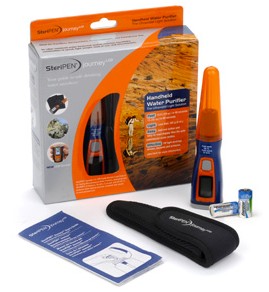SteriPEN Journey LCD Review
Our Verdict
Our Analysis and Test Results
Reliability/Effectiveness
The UV light protects against viruses, protozoa, and bacteria. The question is do you trust it? Waving a wand around in your water somehow doesn't inspire as much confidence as a pump or chemical tablet. However, this method has been used for many years by large water purifying facilities. The way UV light works is that it does not kill bacteria, viruses, etc. Instead, it scrambles the DNA of the organisms so that they cannot reproduce, rendering them harmless to you. One thing to note is that since the organisms remain alive in your water if the treated water is exposed to visible light for a length of time before drinking, the microbes can essentially heal and reactivate.
There are still a few drawbacks: it only works in bottles with openings at least .75 inches wide and the pens are finicky and tend to malfunction on occasion, requiring the user to carry a backup method of treatment (see "personal stories" below.)
Time Before Drinking
With it taking only 90 seconds for a liter and 48 seconds for a half-liter, this one of the simplest, fastest ways to treat a single bottle of water, even though 90 seconds can seem like a long time during treatment. The Platypus GravityWorks system actually treats water faster, taking .05 min for one liter and .50 min for four liters.
Ease of Use
The SteriPEN Journey is very easy to use. It involves filling a bottle from a stream, pushing a button, and waving the wand through the water. A smiley face or frowning face on the LCD screen lets you know if it worked or if you need to do it again. The maintenance replacing the batteries adds more work to this purification system than with some of the pumps like the Katadyn Hiker Pro, that only require maintenance when the filter life is maxed out.
Durability/Uses Before Maintenance
The batteries in the SteriPEN wear out quickly and require frequent charging or replacement, which can be a pain on a multi-day trip in the backcountry. On the plus side, there is no complicated backflushing or filter cleaning work that ever needs to be done, but if the batteries run out while you still have days to go on your trip, you will be bummed.
Also, for an item that is meant to be dunked in water, the whole device is not water resistant and can break if it is completely submerged or drenched in a rainstorm. This makes it less reliable and durable than other methods such as a pump filter.
Personal Stories
We interviewed a couple who thru-hiked the Appalachian Trail to see what they used for over 1,000 miles of hiking. They started their trip with a SteriPEN Journey as their water treatment method because it was lighter than all the pump filters on the market, worked fast, and treated viruses. However, they soon became frustrated because the batteries would wear out very quickly. They needed to carry extra batteries with them or a backup treatment because it would stop working, which added the weight of the whole system. The lithium batteries were very hard to find in towns along the trail and were expensive to continually replace.
One day, they got caught in a rainstorm while hiking. The SteriPEN was packed away in a backpack but still got wet through the pack. The device was broken and would no longer turn on. Ironically, the water purification device was ruined by a little water. The couple ended up ditching their SteriPEN and switching to a Chlorine Dioxide purification method, Aquamira Water Treatment Drops, for the remainder of their hike. They said it was a more reliable system.
Value
At $100, the SteriPEN is slightly more expensive than the average water filter, which typically sells for $80-$90, but is the same price as other UV light purification systems such as the Camelbak All Clear. Keep in mind that during use you will have to shell out money for new lithium batteries, so the cost of the whole system is in reality slightly more.




